It is important to learn all the arguments about and problems generated by the effects we humans create on our home, this land we live upon. By understanding the various issues in a level clear way, and involving all parties, we can arrive at solutions everyone will work to
honor - such was my ideal and what I worked for in Sacramento. Some may consider
this a hopelessly naive idea in today's harsh political clilmate, but I consider
it smart, and what reasonable people want to accomplish.
miI learned that I have
much to learn, and I sincerely welcome comments, which perhaps we could turn
into a book with as many
co-authors as step up to reflect on these issues: whitneye001@hawaii.rr.com. My thoughts are one chapter.
miBelow is the title page of my effort to show what individuals can do. Here is where you can download the whole article: What Can One Person Do? (Environmental Activism in Sacramento) - 66 pages
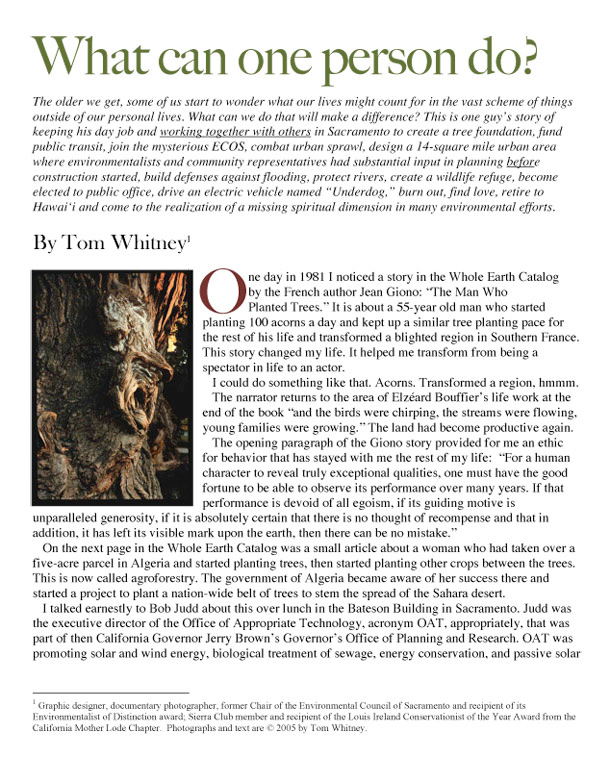

Some lessons learned and perspectives
• Join or help create a local coalition of environmental groups. There are not many of them, and they can be very powerful in helping communities become more livable.
miThe Environmental Council of Sacramento is one of the very few organizations of its kind in the nation. A group like ECOS is a necessary counter-weight on the scales of public justice for the environment. Without an organization like it, the scale will lean too far toward what developers want, which can be insensitive to the environment and short change livability factors like better bikeways, cul-de-sac cut-throughs, more balanced mixed-use, more parks, trees, sidewalks and a better mix of housing types.
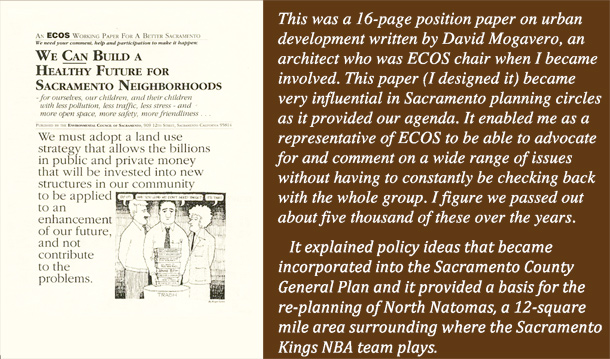
Policy papers like this are very important. I think that the crafting of policy papers, like the one David Mogavero wrote that started the planning efforts of the 1990s, it a very important thing to do. During the North Natomas and the General plan effort that paper and similar articles and books provided the agenda for my efforts and a full explanation for those we were trying to influence. I did not always have to be running back to the board or the president of the organization and asking, “Is it ok if I do this?” It is liberating for an advocate to have papers like that. You point yourself in a particular direction and go. Sure, you report back occasionally to keep everyone on board, and seek further suggestions. But you are free to tactically improvise within that framework of principles on your journey to get them implemented.
After a decade as a member I became chair of this organization for a couple of years. The Environmental Council is a 501 (C)(4) nonprofit (enabling it to lobby) composed of representatives of virtually all local and national environmental groups in the Sacra-mento area, as well as some individual members. Its members include architects, lawyers, ornithologists, engineers, water experts, physicians, low-income housing advocates, chemists, PhDs in one field or another, plain vanilla environmentalists, retired City and County employees, average interested citizens and community organizers. By pooling its specialist professional resources and representing the combined membership of its organizations, numbering about 12,000, the Council is very effective.
In existence for 25 years, it has occasionally and carefully sued the City, the County and developers when necessary and usually won. Thus it is granted a grudging and rueful respect and some clout by developers and public officials.
I have been surprised to find that there are not such councils all over the nation because the idea makes so much sense.
One of the strengths of ECOS in Sacramento is that many of its members work for the state government. Typically government people hesitate to become involved in advocacy groups like ECOS because they feel such membership may create conflicts of interest with their jobs. But ECOS members deal with this in a very legal, above-board and routine way. When an issue will conflict with a person’s job that person will leave the room for the duration of the discussion and vote. Their action is specifically recorded in the minutes of the meeting bu the secretary.
For about thirty years ECOS was an all-volunteer organization. I feel that was one of its strengths. Recently it has hired a person to be the executive director and is now involved in the fund-raising activities necessary to support that person.
You can find out more about ECOS: http://www.ecosacramento.net. - Tom Whitney
• We should look back and evaluate our efforts. This paper has been my effort to do that. I am looking for feedback from others so we can tell the story of a number of the events discussed in the paper from a number of perspectives - the developers, and the public agency managers. If people email me, I will include their comments here and in the paper.
• Talk to people . . . It is important to be open to people with ideas that are different than yours. Talk with them, be willing to work with and learn from them. I have a lot to learn about so many things, and found many people willing to help out. People in development are not all nefarious men and women; most are just trying to make a living out there, working within the legal and policy constraints of the jurisdiction they are in. Most are good people, good citizens, as we environmentalists are. I guess I have come to look on them as people in Congress and the Senate used to relate to one another. They can be enemies/oponents on one issue in the morning and be working together on another issue in the afternoon. They don’t burn their bridges with one another, and we should not, with them.
Don’t paint your opposition with a broad brush and be rhetorical, don’t generalize, be accusatory, personalize issues or make threats. Be specific, be clear, respectful, and keep focused on the problem you are trying to solve. Don’t get mad; get even with your smarter analysis and better strategy. But of course, always keep your eyes open. Constant vigilance, and action, is the price of success. The North Natomas planning process and the Water Forum showed that by working together with your putative enemies in a controlled situation in which the ground rules have been established that give you veto power, you can craft policies both your groups will support, rather than one or the other group trying to undo them.
. . . But don’t be duped. I have been. Be careful when you talk to developers. Some are nefarious. It is probably best to go to any meetings with a developer accompanied by another person from your group to compare impressions, especially when you are early in your involvement. There were a number of times developers called me up and wanted to have lunch to talk about their projects. Working at Regional Transit at the time, I welcomed the opportunity to go eat a good meal at one of Randy Paragary’s many nice restaurants nearby. And I didn’t think I needed to call up fellow ECOS people to accompany me.
Another time, early on in my involvement, and before the new General Plan was approved, a young developer pushing a shopping center project near Elk Grove bought me a lunch and told me about his project. It was difficult to grasp it all, as I was new to the game. He told me about a hearing they were having at the Board of Supervisors and asked if I could attend that. Being open to learn more and naïve about everything connected with development, I went. When I arrived at the hearing the guy came over to me before their item came up on the agenda and I told him I really didn’t have anything to comment on, and he told me that was just fine, just sit off to the side there and listen.
I realized later that he had set me up as a character in his little play that day with the Board, who did know who I was because I had previously testified before them. By coming over and talking with me, and then by my not offering any comment during the hearing on his project, it was as if I was offering tacit approval of what their development group was proposing. At the time, I had no opinion on the project. But unknown to me then, I had been manipulated by that developer. It is still possible I misinterpreted his actions, but I feel the admionition still is valuable. Go with someone else from your group.
I thought ECOS was correct in its later lawsuit over the project. The 295-acre, 1.3 million square foot mall will be about one-fifth bigger than any existing mall in Greater Sacramento. It is located near the County Urban Services Boundary and will induce growth on nearby farmland. ECOS, South County Citizens for Responsible Growth and the State of California sued over the project, but the California Supreme Court overturned the suits in April 2004. The developer pursued his goal relentlessly over a decade, was turned down by the County Policy Planning Commission, and eventually contributed to help plan the incorporation of the new city of Elk Grove, and finance the campaigns of winning city council candidates who favored his mall. A vote for incorporation was in effect a vote for the mall. This slightly underscored a problem in that most ECOS members are residents of the Central City area. The organization needed to broaden its membership. In effect the 20/20 group started by the Audubon Society helped to augment this as the group tended to be centered more in the Eastern part of the County.
The appearance but not the reality of community consultation Mi Another time, representatives of Sares-Regis, a development firm that owned 1,200 acres in the 6,015-acre Sunrise Douglas project area asked me to come to their office to look at their plans. They were designing and pushing their parcel of single-family homes piecemeal and it did not fit into a larger community scheme that at the time seemed possible to occur. What I saw was a sketch of pretty traditional suburban sprawl development on their parcel and told them so. Later I did not see that they had made substantial changes in what they were proposing.
 Sunrise Douglas project area in East Sacramento County along South Sunrise Boulevard in the middle showing large concentration of vernal pools. It was the site of the Sares-Regis project. The pools are formed in the spring in depressions in the heavy clay soil and are the home of an endangered species of crustacean called fairy shrimp, shown on the left. After the pools begin to dry in the spring, beautiful fields of flowers occur as shown on the right. This middle photograph I took helped to make the case clearly that this was a major vernal pool area and was helpful in saving 482 acres of vernal pools on this site. MiM
Sunrise Douglas project area in East Sacramento County along South Sunrise Boulevard in the middle showing large concentration of vernal pools. It was the site of the Sares-Regis project. The pools are formed in the spring in depressions in the heavy clay soil and are the home of an endangered species of crustacean called fairy shrimp, shown on the left. After the pools begin to dry in the spring, beautiful fields of flowers occur as shown on the right. This middle photograph I took helped to make the case clearly that this was a major vernal pool area and was helpful in saving 482 acres of vernal pools on this site. MiM
iMThe aerial photograph above that Brent Thrams and I had taken documented the complex network of vernal pools in the middle of their site – a vertiable archipelago of them - and a study jointly done by three firms, Acanthus, a Sacramento architecture and landscape architecture firm, Concur, and Urban Dynamics for the federal Environmental Protection Agency had demonstrated how the developers could achieve the same or even higher densities with a fresh look at incorporating transit oriented development policies in their design scheme. In addition there were unresolved issues regarding a reliable water supply.
MiRecently, reviewing Business Journal articles over the past number of years, I saw I was quoted as approving the idea that they were setting aside 482 acres of vernal pools on their 1,200-acre site. In 1998, I said "We think it was the totally appropriate thing to do, and we're happy to see Sares-Regis has been working so constructively with Fish and Wildlife," said Tom Whitney, a spokesman for the Environmental Council of Sacramento, a coalition of groups.” I would say that again.
MiThen in a Sacramento Business Journal article four years later by Mike McCarthy on August 23, 2002, after ECOS and a neighborhood group filed suit against the project, I was referenced: “But in another way the lawsuit was a surprise, said development coordinator Hodgson. That's because ECOS was part of a county-appointed committee that came up with the basic plan for Sunrise-Douglas and Sun Ridge during the late 1990s. “The Environmental Council, represented then by Tom Whitney, helped create the plan that the county adopted. ‘Tom Whitney was no pushover, and he was definitely part of our landowner group,’ Hodgson said. ‘He attended most of our meetings and he voted for the land-use plan and the plan hasn't changed since then. The rationale for creating such committees is to find consensus,’ he said, and avoid such disputes as lawsuits. On top of that, ECOS said little at later public hearings on the plan, he said.”
MiI didn’t see the article at the time. It was untrue to say that I was “definitely part of their landowner group,” because I was not! Any suggestions I made when visiting their office alone with Hodgson were not implemented, so far as I could see. I never attended one of their developer group meetings. I did attend the community plan meetings run by the County. The ignored the suggestions I made to Hodgson. They staged the appearance of involvement, not the substance of it.
MiAs to his comment that I was part of a County-appointed committee that “came up with the basic plan,” that is slightly, only apparently true. The County and City do these community plan meetings all the time, but the operational reality of what happens is very different. In this and other cases the County-appointed committee of citizens did not come up with the plan, the plan was presented to the “County-appointed group” by County staff after being hashed out with developers.
MiThose staff people who had made the plan did not entertain suggested changes. They would hear the voices of the community, but those voices did not result in much change in the document under consideration. I got the sense that staff took pride in being impervious to input. I think that is what happened with the Sunrise Douglas plan. In such meetings community members are presented with many elements of boilerplate infrastructure design not open to debate and which many community members do not grasp. Staff spends most of its time educating community members what they are talking about. Typically there is no creative input welcomed from the group on the fundamental elements of the plan, so to say that the group created the plan is very misleading.
Many ECOS members know that many, if not most, of these infrastructure policies are in need of drastic reform, but the community representatives in such meetings do not.
And County Planning was conducting the meeting. When representatives from Public Works, Transportation, Water Quality or Water Resources appear at Community Plan meetings it was to verbally review their boilerplate policies as applied in this instance, not to solicit or entertain suggestions for change to the basic boilerplate policies. Thus there is an inherent weakness of this kind of planning which is pervasive.
As environmentalists belabor our points in meeting after meeting we can become seen as shrill, obstructionist and isolated from the group – dismissed as a minority with an obstructive view. Thus when attending such meetings you don’t always have the stomach for that, particularly when it is not your community. I was not part of the Rancho Cordova – Sunrise community. You make your points but hold back, so others can voice their concerns. This demonstrates the value of seeking out ECOS members who live in communities across the County. During my time in Sacramento more ECOS members lived in the central city than in the suburbs.
It has taken me years to grasp how, at least with County Planning in the early to mid 1990s, there was the pose of soliciting community input;inclusion,;consensus. But the operational reality of what was going on was opposite, however well meaning County staff were. It created the form and appearance of community participation, but the substance was far different. This is why the North Natomas and Water Forum processes were so unusual. I think a review of City and County public participation policies is called for.
As to the comment that ECOS said little at later public hearings,it shows how mere presence at a meeting can be interpreted as tacit approval. If you go to a meeting and have an opinion, state it.
 Even
the best of intentions can come to no good end.
In Westley, California, near Modesto
many years an enterprising man had collected
the largest tire pile in the world. Tires were trucked
from all over California and stored in a huge
pile
that was protected from vandalism behind a high
guarded fence. The pile eventually came to number
more than
7 million tires at the time this picture was
taken by me. One unfortunate day in September,1999,
lightning
struck and the tires ignited. It took thirty
days to control the fire.
Even
the best of intentions can come to no good end.
In Westley, California, near Modesto
many years an enterprising man had collected
the largest tire pile in the world. Tires were trucked
from all over California and stored in a huge
pile
that was protected from vandalism behind a high
guarded fence. The pile eventually came to number
more than
7 million tires at the time this picture was
taken by me. One unfortunate day in September,1999,
lightning
struck and the tires ignited. It took thirty
days to control the fire.
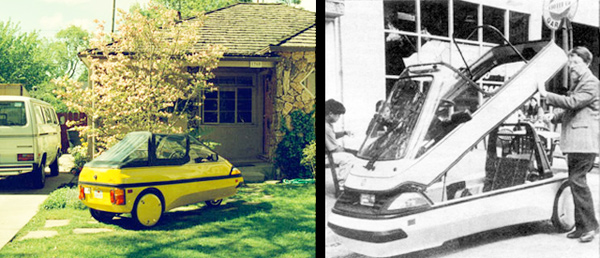
Electric
and hybrid vehicles are the future.
I was an "early adopter" and purchased this sweet Danish
"City El" electric vehicle when It became available.
It was perfect for Sacramento. It moved at 35 m.p.h and
handled mid-town travel for one passenger just fine.
I joined the Electric Vehicle club at SMUD that Ruth
MacDougal coordinated. The experience offered great insight
as to how the auto industry evades regulation. General
Motors developed their excellent EV1, they pre-empted
the field, and then dropped it like a hot potato. SMUD, the publicly-owned electric utility that already had the largest photovoltaic power plant in the nation, couldn't have been acting more responsibly in that in the early 1990s they developed a fleet of a hundred and fifty electric vehicles of all types, testing the new technology. It was great fun seeing the ingenuity of local builders of electric vehicles. We were there at the start of something new and exciting.
Travel
to other lands brings important perspectives.
Travel is important for a mature view of the world. In
Sacramento in the 1990s we were promoting transit-oriented
development. For U.S. developers it was a new concept.
This is why world travel can be important. You can see
that transit villages exist in other parts of the world,
as shown here in this photograph taken in Holland. Also
remarkable was the lack of fences in agriculture areas,
which as you can see here extended right up to the high
rises. They do Western Civilization pretty well over
there! See this section for a demonstration of this paragraph's point: newgraphicdesignpage.html
Community views of Tom Whitney
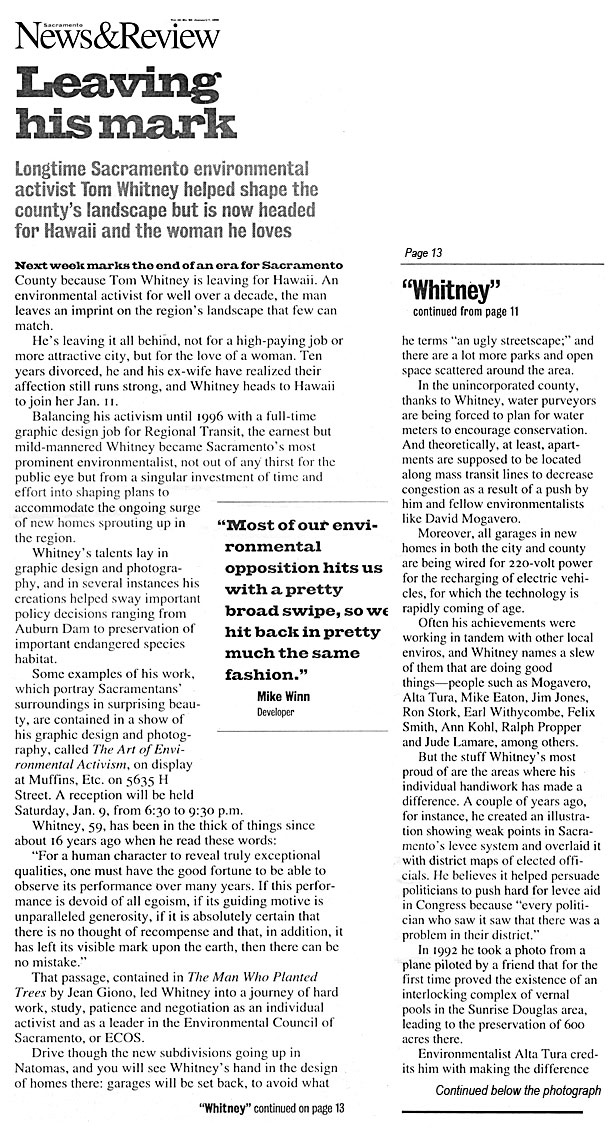
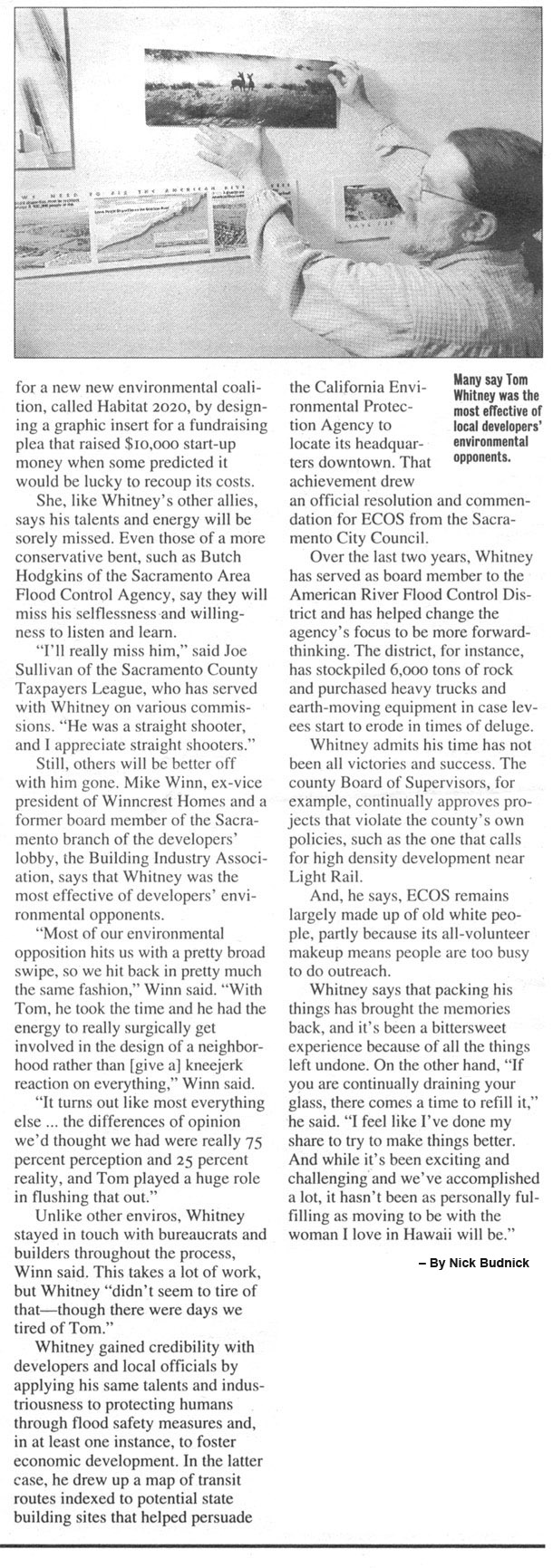
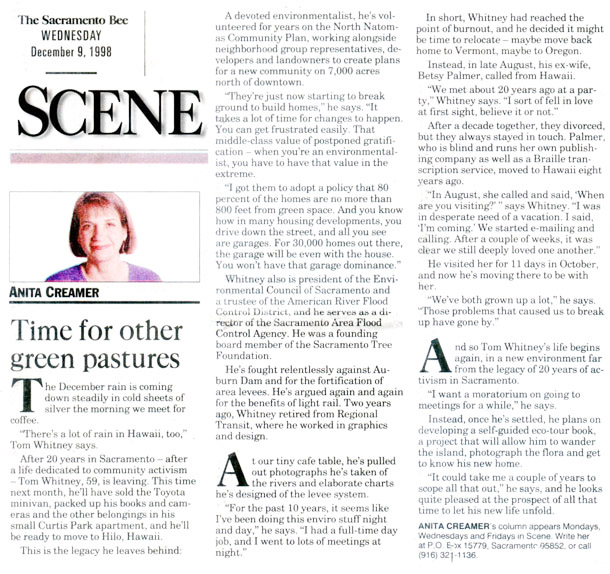
The
items above are discussed in the downloadable PDF
"What
Can One Person Do?".

